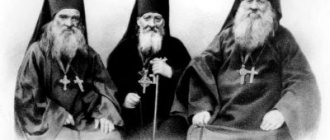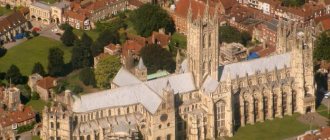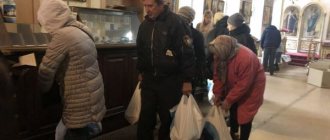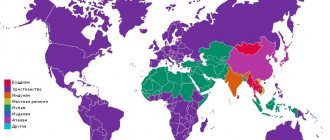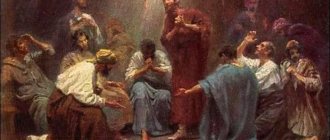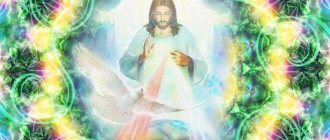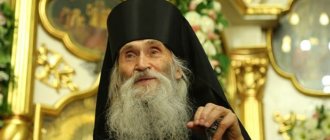| Name | Connection method | |
| Rome - Catholic Church | those who have been confirmed - rank 3, through repentance | |
| those who have not been confirmed -2nd rite, through confirmation | ||
| Armenian Apostolic Church | 3 by rite, through repentance | |
| Old Believers | Belokrinitsky | 2nd rite, through confirmation |
| bespopovtsy | 2nd rite, through confirmation | |
| Anglicanism | 2nd rite, through confirmation | |
| Lutheranism | 2nd rite, through confirmation | |
| Presbyterians | 2nd rite, through confirmation | |
| Pentecostals | 2nd rite, through confirmation | |
| Evangelical Christian Baptists | 2nd rite, through confirmation | |
| Various schismatic communities (provided that the person received the sacrament of baptism there) | 2nd rite, through confirmation | |
| Jehovah's Witnesses | 1st rank, through baptism | |
| Judaism (Jews) | 1st rank, through baptism | |
| Islam (Muslims) | 1st rank, through baptism | |
| Pagans | 1st rank, through baptism | |
In accordance with the rules of the Orthodox Church, the reunification of a person with the Church is carried out with the blessing of the diocesan bishop. According to the existing order in the Moscow diocese, in order to receive a blessing for a person to join the Orthodox Church, he needs to submit to the diocesan administration a petition addressed to Metropolitan Juvenaly of Krutitsy and Kolomna, supported by the rector of the church where the person wishing had an interview on this issue and, after receiving the blessing, perform the rite reunion. In this case, it is necessary to take into account how much the reunited person is instructed and enlightened in matters of the abandoned (former) faith. And if he was a Muslim or a Jew only by the fact of actions performed on him after birth, then such actions are accepted through baptism. If the person being reunited was a practitioner (that is, fulfilling the rules and rituals of his confessions), then the reunification must be carried out using all the actions required by rank with the obligatory announcement and writing of a petition addressed to the ruling bishop. Below are diagrams of the rite sequence of the rites of accession in accordance with the traditions of the Russian Orthodox Church and found in various editions of the Additional Trebnik
The rite of joining Orthodoxy through the Sacrament of Baptism (1 rite) Scheme of the rite Psalm 33: “I will bless the Lord at all times...” Questions and teachings, questioning, kneeling. Prayer “Blessed art thou, O Lord, from all tongues...” First announcement: Psalm 8: “O Lord our Lord, how wonderful is Thy name...”; instruction; questioning; denial; combination to God. The second announcement: questions, confession of the Orthodox faith; prayer “Great God, enlightening the primeval darkness...”; prayer “Great and Wonderful God...” And then the sacrament of Holy Baptism is performed according to the rite of the Orthodox Church.
The rite of joining Orthodoxy through the Sacrament of Confirmation (2nd rite)
Scheme of rites Confession of sins Prayer “Lord God of truth, look upon Thy servant...” Questions about wrong teaching and its denial Creed Questions about the Orthodox faith and confession of it Psalm 66: “O God, gracious to us...” Prayer: “Lord God Almighty to those who sin offer images of repentance...” Promise to keep the Orthodox faith intact Prayer of permission: “Our Lord Jesus Christ, who handed over the keys of the Kingdom of Heaven to the Apostle...” “Blessed is the Kingdom...” “To the Heavenly King...” Great Litany Prayer: “Blessed art thou, Lord...” Anointing of the one being joined with myrrh with the utterance of the words: “Seal of the gift of the Holy Spirit, Amen” Laying the cross on the anointed one Prayer “Lord our God...” Wiping off the parts of the body anointed with the myrrh Secret prayer: “Having been clothed in Thee Christ and our God...” Litany: “Have mercy on us , God..." Let go
The rite of joining Orthodoxy through the Sacrament of Repentance (3 rites)
Scheme of rites Confession of sins Questions about the sincerity of renouncing previous errors and about the desire to join Orthodoxy Prayer: “Lord God Almighty...” Questions about renunciation of errors and the denials themselves Confession of the Orthodox faith Prayer of permission with blessing Communion of the Holy Mysteries
Russian Orthodox Church
“I congratulate all of you, dear brothers and sisters, on an important event in your life - reunification with the One, Holy, Catholic and Apostolic Church.
Our Lord Jesus Christ warned His disciples: Many will come in My name and say, “I am the Christ,” and will deceive many (Matthew 24:4). The Lord also said that not only wheat, but also tares would be sown in the same field (see Matt. 13:3-23; Mark 4:3-20; Luke 8:5-15). The holy apostles also wrote in their epistles that many false prophets and false Christs will come and seduce people.
But we know that there is one truth, just as there is one Christ. He founded His Holy Church on earth, about which he told the apostles that the gates of hell would not prevail against it (Matthew 16:19). There is one church, there was no other, there is not and there will not be another. And it is this Holy Church that we confess in the Creed - the One, Holy, Catholic and Apostolic Church. You were baptized in it, but due to various circumstances, each of you deviated from it: some into schism, some into heresy, and some into sects.
There is a big difference between these three different degrees of departure from the Church. Schisms arise within the Church. Sometimes it happens that a schism arose, but over the years its founders came to their senses and reunited with the Church. Heresy is a distortion of the teachings of the Church, when human wisdom is introduced into the teaching left to us by Christ Himself and His apostles, as a result of which the truth of God is distorted. And a sect is such a perversion of Christian doctrine, in which very little or nothing at all remains of Christianity - instead of truth, people will be offered a lie.
Each of these deviations is cured by repentance and return to the true Church. You have walked this path, and I would like to wish you that never again will you incline your ears to the preaching of false teachers. If someone tells you that the Orthodox Church is untrue or imperfect, that there are some higher teachings, do not believe these false teachers. Yes, the Orthodox Church consists of living people who have their own shortcomings, and church life has its own problems. I think that if the Lord wanted to create His One, Holy, Catholic and Apostolic Church so that it would be without any problems and without shortcomings, He would have created it from angels, and not from people. Since the Church is created from people, it itself is holy, and the people in it are sinners, but these are people who have taken the path of correction and repentance; they saw before them the ideal of holiness in the person of the saints who had shone forth in the Church over many centuries.
We see images of these saints both on the icons in the iconostasis and on the frescoes on the walls of the temple, we read their lives and understand that the path of holiness is open to every person. But this path is difficult, it requires spiritual achievement and constant sobriety. You have embarked on this path, and I wish you to follow it to the end.
The end of this path is the Kingdom of Heaven, about which the Lord said that it was approaching (see Matt. 4:17). It has approached not in chronological terms, not in the sense that the end of the world is about to come, as some false teachers preach, but the point is that the Kingdom of Heaven is not somewhere far away - it is here, among us. We join him when we come to the temple of God, participate in the Divine Liturgy and partake of the Holy Mysteries of Christ - then the Lord Himself with His Body and His Blood enters our body and our blood.
Some Christian denominations say that the Eucharist is simply a remembrance of the Last Supper, and the bread and wine are only a symbolic representation of the Body and Blood of Christ. We in the Orthodox Church believe that the bread and wine at the Eucharist are the true Body and true Blood of our Lord Jesus Christ. And it is this Body and this Blood that gives us the opportunity to unite with God spiritually and physically, so that God begins to live inside us and act through us, and we become instruments in His hands.
In order to never again deviate from error, I recommend and ask you to read the Holy Gospel daily, as often as possible to turn to other books of the Bible - the epistles of the holy apostles, the Old Testament, read the interpretations of the holy fathers, and other Orthodox literature that is available to everyone today person, and never get acquainted with heretical, sectarian, schismatic literature, because it can seduce a person and instill in him distorted ideas about the Church and the world around him.
I wish you to go to church as often as possible, to learn the law of God through the hymns and prayers that you will hear during divine services, to regularly come to confession and on Sundays and holidays to partake of the Holy Mysteries of Christ, so that you live in Christ, and Christ lives in you .
I cordially congratulate you on this event and wish you a grace-filled path to the Kingdom of Heaven. Amen".
Preparation for the Ceremony of Accession
Preparation for the Rite of joining the Orthodox Church takes place at the Church Rehabilitation Centers of the Moscow Diocese. Here, an individual Rehabilitation Program will be developed for each person joining and will be helped to implement it. As a rule, it takes 2-3 months and includes reading specially selected books, articles, watching videos, discussing and mastering the main provisions of the Orthodox Church. To help those who are preparing to join Orthodoxy, on the recommendation of specialists from the Rehabilitation Center, the following literature can be offered.
Literature recommended for independent reading for people preparing to join the Orthodox Church
| The religion from which a person transfers to the Orthodox Church Pagan false teachings: I Occult Shamanism Reiki Theosophy New Age Neopagans II Eastern religions and false teachings: Buddhism Hinduism Neo-Hinduism Yoga Sikhism Shintoism Confucianism Taoism Jainism Zoroastrianism, etc. III Islam IV Roman Catholic Church, Eastern Catholic churches Protestant and neo-Protestant sects: V Lutherans Anglicans Calvinists VI Evangelical Christians, Baptists (shtunda), Charismatic Pentecostals, Jehovah's Witnesses, Methodists, etc. Schisms: VII Old Rite VIII Assyrian Church of the East (Nestorians); Armenian Apostolic Church, Coptic Orthodox Church; Ethiopian Orthodox Church; Eritrean Orthodox Church; Syrian Orthodox Church; Malankara Orthodox Church | Literature recommended for reading 1. Priest. Dimitry Druzhinin “Wandering in the Dark: the main provisions of the pseudo-theosophy of Helena Blavatsky, Henry Olcott, Annie Besant and Charles Leadbeater” pdf fb2 2. S.L. Khudiev “Occultism: the false path” pdf, fb2 3. Deacon Andrey “Satanism for the intelligentsia. About the Roerichs and Orthodoxy” volume 1 fb2, volume 2fb2 4. Elena Balashova “The experience of rethinking reiki” pdf, fb2 5.A.I. Andreev “Himalayan Brotherhood: Theosophical Myth and Its Creators (Documentary Investigation)” pdf 6. V. Apshay, R. M. Kon “Basic provisions of Waldorf pedagogy from the Orthodox point of view” pdf 7. M. N. Kuznetsov. “Russian neo-paganism. History, idea and myths" pdf, fb2 8. S. Alekseev, priest. Georgy Maksimov, A. Mahler “Myths of Neo-Pagans”doc 9. A.I.Solodkov “Caution, Neopaganism!” doc 1. Priest. Georgy Maksimov “St. Nicholas of Japan on Buddhism” pdf, fb2 2. Priest. Georgy Maksimov “How is Orthodoxy different from Buddhism?” pdf, fb2 3. V.Yu. Pitanov “Idols of neo-Hinduism: Sri Ramakrishna and Swami Vivekananda” doc 4. V.Yu. Pitanov “Krishnaism as a tradition of worshiping deception and death” fb2 5. Prot. O. Stenyaev “Hare Krishnas, who are they?” doc 6. Ep. Alexander (Mileant) “Seven-headed dragon. Indian-occult teachings in the light of Christianity”pdf, fb2 7. S.L. Khudiev “Did Jesus teach reincarnation?”pdf, fb2 8. Priest. Georgy Maksimov “Orthodox view of yoga” fb2 1. Priest. Georgy Maksimov “Orthodoxy and Islam” fb2 2. Priest. Daniil Sysoev “Islam. Orthodox view” fb2, pdf 3. S.L. Khudiev “Has the Church distorted the message of Jesus? Response to Muslim criticism of the Gospel" PDF, fb2 1. Priest Georgy Maksimov "Policy with Catholicism with Saint Gorazd of Czech" pdf 2. Bishop Mitrofan (Znosko-Borovsky) "Orthodoxy, Roman Catholicism, Protestantism, sectarianism" pdf 1. A.I. .Solodkov “Mission in a heterodox environment” doc 2. A.I.Solodkov “Help the lost.” Audio course lectures on sect studies 3. Priest. G. Maksimov “Orthodoxy and Protestantism: what is the difference” pdf 4. Priest. G. Maksimov “The Question that Protestants Never Ask” pdf, fb2 1. R. M. Kon “Introduction to Sect Studies” epub fb2 pdf 2. I.A. Glukhov “Sectology” doc 3. Priest. Georgy Maksimov “A Gift to a Protestant Friend” pdf 4. Archbishop Alexy (Dorodnitsyn) “South Russian Neo-Baptism, known as Shtunda” pdf 5. R.M. Horse “The Baptists’ Concept of Grace” pdf 6. R.M. Horse “Comparison with the Baptists” pdf 7. Priest. E. Veselov “False prophecies about the future in the light of Christ’s truth: Orthodox assessment of the eschatological doctrines of Baptists, Pentecostals, Seventh-day Adventists and Jehovah’s Witnesses” pdf 8. Diak. A. Kuraev “To Protestants about Orthodoxy” pdf, fb2 9. Archpriest D. Vladykov “The Orthodox Church and Sectarians” pdf, fb2 10. Martyr. N. Varzhansky “Good Confession. Orthodox anti-sectarian catechism" pdf 11. Prot. T. Butkevich “Review of Russian sects and their interpretations” 12. Igum. John (Rubin) “Neo-Pentecostalism. Protestantism or occult sectarian movement" (conference materials) pdf 13. Archim. George (Kapsanis) “Our Orthodox Faith and the Misconceptions of Jehovah’s Witnesses” pdf, fb2 14. Priest.N. Dubinin “Danger with a Bible in your hands. About the sect "Jehovah's Witnesses" fb2, pdf 15. Prot. Oleg Stenyaev “Dispute with Jehovah’s Witnesses” fb2 16. Priest. D. Sysoev “Anthropology of Seventh-day Adventists and Jehovah’s Witnesses” pdf, fb2 17. Ep. Innocent “Why do Christians celebrate the Resurrection and not the Saturday (answer to Seventh-day Adventists)” pdf 18. Bishop Alexander (Mileant) “False teaching of the Mormons” fb2 19. A.I. Solodkov “Baptism. Mission in a heterodox environment” doc 20. A. AND. Solodkov “Charismatic sect “New Generation” pdf 21. Priest. I. Efimov “False testimonies of Jehovah's Witnesses pdf, fb2 1. St. Filaret of Moscow (Drozdov) “Conversation to the Verbal Old Believer about the Hundred Main Cathedral and about true harmony with the Orthodox Church” pdf, fb2 2. Archimandrite. Mikhail (Kozlov) “Conversations with the Old Believers of the head of the Transbaikal anti-schism mission” pdf, fb2 3. E.E. Lebedev “Unity of faith in counteracting the Russian ritual schism” pdf 1. Prot. A. Ivantsov-Platonov “Heresies and schisms of the first three centuries of Christianity” pdf, fb2 |
First announcement
After sufficient time of instruction, after Vespers, the primate puts on the sacred robe, as was said before, and, having bowed three times before the altar and kissed its edge, proceeds from the altar to the door of the church.
Usually a period of up to a year was considered necessary. But a forty-day period of announcement is still normal (and canonically necessary). However, a formal approach to the time of announcement is inappropriate. It is determined by a person’s readiness to receive the Sacrament. In case of illness, the period of announcement may be shortened or even canceled (but only if there is a threat of death).
The announcement begins after Vespers, in the presence of the entire church community, in front of which a person renounces his errors. And again the rite begins with thanksgiving to God for the conversion of the lost. The service begins from the throne as a sign that the Lord is the Beginning and the End of all creation and from Him we draw strength to accomplish every good deed, especially such a great one as the liberation of man from slavery to Satan.
As the primate walks, the choir greets those who wish to join with the words of Psalm 8, in which St. King David describes the greatness of the saved man now beheld in Christ.
Lord our God! How wonderful is Your name throughout all the earth! Your glory extends above the heavens! From the mouths of babes and sucklings You have made praise for the sake of Your enemies, in order to silence the enemy and the avenger. When I look at Your heavens, the work of Your fingers, at the moon and the stars that You have set, what is man that You remember him, and the son of man that You visit him? You made him a little lower than the Angels: You crowned him with glory and honor; You have made him ruler over the works of Your hands; He put everything under his feet: all the sheep and oxen, and also the beasts of the field, the birds of the air and the fish of the sea, everything that passes along the beaten paths of the sea. Lord our God! How majestic is Your name throughout the whole earth!
The catechumen stands on the porch (outer porch), looking inside the temple. And the primate says to him:
Now, child, the time for your instruction is over. So, if you were specifically asked whether, for the sake of the love of Christ and the salvation of your soul, you want to be a Christian, however, you must now and before the church meeting express this, renounce the first false faith in which you were, and clearly confess the Orthodox faith (proclaim aloud).
To ensure the sincerity of the conversion, he is invited to confess his faith before the eyes of the Church. After all, by Baptism a person becomes a full member of both the Universal Church and this particular parish, and therefore parishioners have the right to know who they are receiving. On the other hand, renunciation of errors is also necessary for the person being joined. He gets the opportunity to feel that Baptism is a turning point in his life. He evaluates Islam, in which he was previously, by the light of Divine Revelation, and understands that it is necessary to reject it, and not make some kind of synthesis from two incompatible religions. But now let us consider those renunciations that the one who joins proclaims.
Question: Do you renounce the faith of the Mohammedans and all their false wisdom, and do you abandon it completely?
Answer: I sweep away and abandon the Mohammedan faith and false wisdom.
The Mohammedan faith is worthy of rejection, for it stands on the foundation of false prophecy, and therefore cannot be united with the word of God. The differences between Mohammedanism and Christianity are rightly called false wisdom. After all, if a person tries to correct the Creator based on his own considerations, there is no other way to call it. The former Mohammedan does not renounce either monotheism or the true prophets (whom, however, he had not truly revered before), but only the insane assertions that God is the creator of evil, that Christians consider the Virgin Mary to be a goddess and is the sister of Moses, and the like .
Question: Do you renounce Mohammed as a false prophet?
Answer: I admit that he is a false prophet and renounce him.
In the light of the Bible, it is obvious that Muhammad was a false prophecy. He taught contrary to previous prophets, did not give any evidence of his messengership, and did not leave a single fulfilled prediction. His revelations were accompanied by signs of possession by evil spirits. All this suggests that he is a false prophet.
Question: Do you renounce Al-Quran and all the false stories, laws and traditions contained in it?
Answer: I renounce Al-Quran and all the false stories, laws and traditions it contains.
As a result, it is natural to reject the imaginary Revelation of God - the Koran, which in many points contradicts the true Revelation - the Bible.
Question: Do you reject Mohammed’s ruling on traveling to Mecca for the sake of worship there, supposedly to save the soul?
Answer: I reject it as superstitious.
Indeed, this ritual was not established by the Creator. And if so, then it is stupid to think that walking in a circle around a black stone, slaughtering sheep and throwing stones at a rock can somehow save a person. Moreover, this is meaningless since the very veneration of the Black Stone of the Kaaba goes back to paganism.
Question: Do you renounce the Mohammedan seductive teaching about polygamy in this life, and about sensual pleasure in paradise after death?
Answer: I renounce and reject this teaching, invented to please the flesh.
At the beginning of creation, God created one couple, whom he married. Therefore, the normal form of marriage is monogamy. In the Church, marriage is sanctified by the Creator and therefore it is impossible to introduce norms of cohabitation that appeared due to the depravity of mankind among the descendants of Cain (Gen. 4:19). The main reward of the Kingdom of Heaven is communication with God, and not the pleasure of the body. Christ said that “in the resurrection of the dead they neither marry nor are given in marriage, but remain as the angels of God in heaven” (Matthew 22:30). Therefore, the idea of heaven as a place of drunkenness and debauchery is unacceptable for Christians.
Question: Do you renounce all the lies and blasphemies that the Mohammedans spew out against Christ, His Most Pure Mother and Christians?
Answer: I renounce.
Of course, it is not permissible for a person who has converted to Christianity to believe that the Lord Jesus Christ is just a Man who escaped from the Cross, that He performed meaningless miracles, such as lowering a table from the sky or reviving clay birds. Or that the Mother of God is the sister of the prophet Moses, or that Christians believe in the physical cohabitation of God and the Virgin Mary, who is also supposedly considered a goddess. All these blasphemous fabrications must be rejected.
Question: Are you truly, unfeignedly and without doubting anything, with all your soul, united with the one true God glorified in the Trinity, and do you believe in Him?
Answer: I unite truly, unfeignedly and without any doubt, with all my soul, to the one, true, glorified God in the Trinity, and I believe in Him.
After renouncing error, it is necessary to proclaim true faith in God and His Revelations. We explained its essence in the interpretation of the Creed, so we will simply give a translation of the second announcement into Russian.
Login to the site
In 1757, with the blessing of the Holy Synod, a separate book was published, “The rites of those uniting from other faiths to the Orthodox-Catholic Eastern Church,” containing the same rites of joining non-Orthodox people through Baptism, Confirmation and Repentance, which are found in the Breviary of Peter the Mogila.
The “Book of Orders of Joining Orthodoxy› contains the rites of joining the Orthodox Church of persons coming from the Roman Latin, Armenian, Lutheran and Reformed faiths. The book contains rites for the reception into the Orthodox Church of non-Christians and Christians of other confessions: a) through the Sacrament of Baptism (pagans, Jews, Mohammedans), b) through the Sacrament of Confirmation (Lutherans, non-confirmed Catholics and Calvinists), c) through the Sacrament of Repentance (those who was baptized and anointed, but fell away from the Orthodox Church and fell into schism).
The book is an extract from the Great Trebnik of some chapters (97, 98, 103-106) with several additional articles. The rites for the reception of non-believers into the Church are contained in the book “The Order of those united from non-believers to the Orthodox Catholic Eastern Church” and in the Great Trebnik. But since the confession of the Orthodox faith found in the Great Book of Breviaries with the Jew’s renunciation of his errors and heresies and the Mohammedan’s renunciation of his false teachers contains indications of many such errors and such false teachers who are now practically unknown to Jews and Mohammedans, the rite of announcement they are performed not according to the Great Trebnik, but according to the “Book of Rites of Joining Orthodoxy.” In the Trebnik of Peter the Mogila in the decree “about how to receive from heretics the apostolates of the Catholic Church who come to the holy apostles of God” about the third category of non-Orthodox, i.e. baptized in the name of the Holy Trinity and anointed, it is said that “they, precisely after their renunciation and apostasy, confess the Symbol of the Orthodox Faith and confession of their sins, and through prayers and the permission of the hierarch they are cleansed according to the lower rank.” And this rite is the same one that is placed in all later editions of “The Order of Orders United from Other Faiths,” published in 1757, 1831, 1845. According to this rite, the bishop or priest asks the person turning to Orthodoxy whether he regrets and repents from the bottom of his heart for his departure from Orthodoxy and whether he wants to be obedient to the Church in everything and remain unwavering in the unity of the Orthodox faith until the end of his life. Having received affirmative answers to these questions, the clergyman marks the person being converted three times, saying: “In the name of the Father and the Son and the Holy Spirit, amen.” Laying his hand on his head, he reads the prayer: “Lord God Almighty, the only holy thing, and rest on the saints...”, after which follow questions about denials of errors and the denials themselves, confession of the Orthodox faith, a prayer of permission with reverence and, after all, communion Holy Mysteries
| Content | |
| The pages correspond to the numbering of the e-book | |
| I. The order of how to accept the age of those who have property from the Jews, who come to the One Holy Catholic Apostolic Church and truly desire to copulate with that one. | 3 |
is how to announce on the first day the age of those who have property and the names of Christian taxes to them. | 4 |
| 14 |
| 20 |
| 33 |
| 37 |
| 39 |
| 41 |
| 41 |
| II. The order of how to accept the age of those who have from the Saracens, that is, the Turkish, or some other Mohammedan evil wickedness, who come to the One Holy Catholic Apostolic Church and truly desire to copulate with that | 59 |
| 70 |
| 76 |
| III. The order of how to receive those who come to the Orthodox Faith, who have already been faithful believers, but were raised in heresy from childhood, having true Baptism: In the name of the Father, and the Son, and the Holy Spirit, and rejecting other holy mysteries and church customs, and other contrary opinions Orthodox churches containing. | 89 |
| 102 |
| IV. A rite to anoint with myrrh those who come to the Orthodox faith and those who unite with the Catholic Church from heretics. | 104 |
| V. A decree on how to receive heretics or apostates, and the Holy Church to embrace them, but it is not appropriate to anoint them with holy chrism, according to the 95th canon of the Holy Sixth Council of Trullo. | 114 |
| VI. The order of how to accept into the Orthodox Catholic Church those who have departed from it to Jewish unbelief, and those who have repented, and those who want to join the Orthodox faith. | 116 |
| 146 |
| The order of how to accept those who have apostatized from the Orthodox Catholic Church to Turkish wickedness, and who, having repented and put aside this atheism and unbelief, wish to unite with the Orthodox Faith | 148 |
| 176 |
| The order of how to accept those who come from schismatics into union with the Orthodox Church. | 178 |
| 189 |
